The Sore Throat Lozenges Market is estimated to be valued at USD 4.3 billion in 2025 and is projected to reach USD 7.5 billion by 2035, registering a compound annual growth rate (CAGR) of 5.5% over the forecast period.
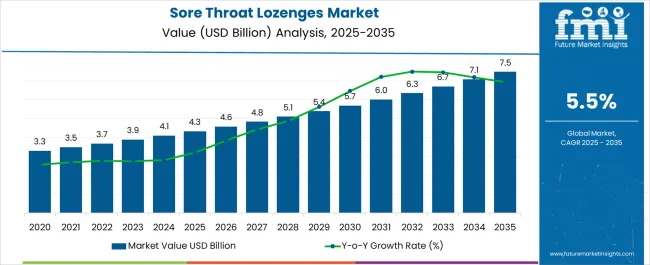
| Metric | Value |
|---|---|
| Sore Throat Lozenges Market Estimated Value in (2025 E) | USD 4.3 billion |
| Sore Throat Lozenges Market Forecast Value in (2035 F) | USD 7.5 billion |
| Forecast CAGR (2025 to 2035) | 5.5% |
The sore throat lozenges market is growing steadily, fueled by seasonal flu incidences, rising air pollution, and increased consumer preference for quick-relief solutions. The availability of lozenges as convenient, over-the-counter formulations has expanded their adoption across all age groups.
Market growth is also supported by continuous innovation in flavors, sugar-free variants, and natural ingredient integration, aligning with consumer demand for both efficacy and palatability. Expanding pharmacy networks and growing online distribution have improved product accessibility.
Furthermore, heightened consumer focus on self-care and preventive healthcare is reinforcing demand for lozenges as first-line relief solutions. The market outlook remains positive, with ongoing demand in both developed and emerging economies and opportunities for expansion through herbal and functional product development.
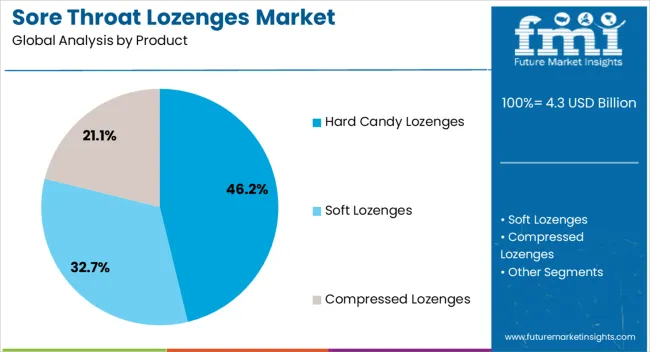
The hard candy lozenges segment holds approximately 46.2% share of the product category, reflecting its position as the most widely used format in the market. Its dominance is linked to extended dissolution time, which allows gradual release of active ingredients for prolonged soothing effects.
Hard candy lozenges are easy to carry, affordable, and available in a wide range of flavors, driving consumer acceptance. Manufacturers have enhanced this segment with sugar-free and herbal-based variants to align with evolving consumer preferences.
With consistent demand for effective, convenient sore throat relief, the hard candy lozenges segment is projected to maintain its strong market share.
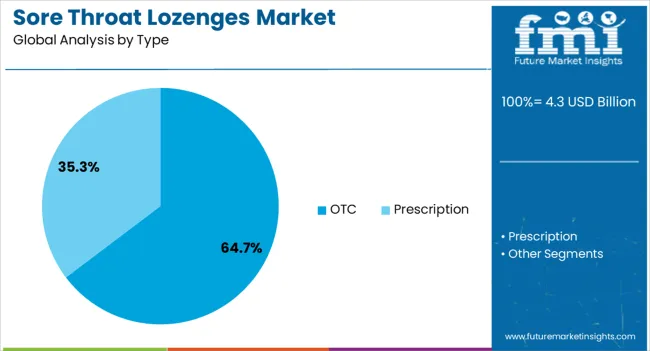
The OTC segment leads the type category with approximately 64.7% share, owing to broad accessibility without prescription and strong reliance on self-care practices. Consumers prefer OTC lozenges for immediate relief, bypassing the need for medical consultation.
The segment benefits from established brand recognition and widespread retail availability. Manufacturers have invested in marketing strategies to reinforce OTC product trust and consumer familiarity, ensuring continued demand.
With increasing global preference for affordable and easily available treatment options, the OTC segment is expected to sustain its leadership.
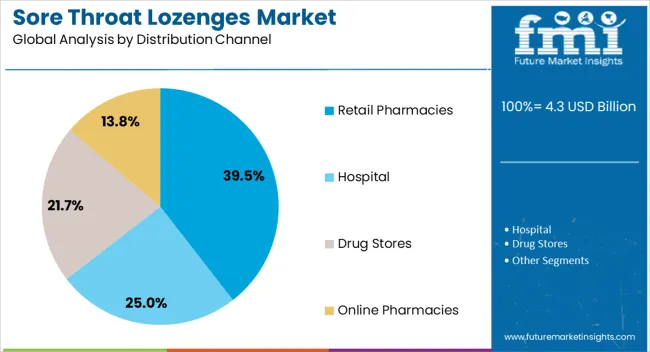
The retail pharmacies segment represents approximately 39.5% share of the distribution channel category. Its prominence is driven by consumer reliance on pharmacies for immediate purchase of over-the-counter healthcare products.
Pharmacist recommendations and strong in-store visibility of branded lozenges further strengthen this segment. Retail pharmacies also serve as trusted outlets, particularly in regions where e-commerce penetration is limited.
With consistent demand during seasonal illness peaks and expanded pharmacy networks in emerging markets, the retail pharmacies segment is anticipated to remain a key distribution channel for sore throat lozenges.
The sale of sore throat lozenges market expanded at a CAGR of 4.9% during the historical period, owing to a rise in over-the-counter (OTC) medications, especially for common cold and flu remedies.
| Attribute | Details |
|---|---|
| HCAGR (2020 to 2025) | 4.9% |
The market for sore throat lozenges is expected to rise over the forecast period. This is because of the increase in demand for these decongestants due to increasing cases of nasal and throat infections, especially during seasonal changes. Children are at higher risk of acquiring infections, and they prefer these lozenges over any other second line of treatments available.
Additionally, throat lozenges are used as the initial course of treatment for sore throats, colds, and flu. Moreover, among all flu strains, the common cold is the one that individuals tend to cure at home rather than constantly seeking medical attention. This is one of the reasons for the growth of the market for sore throat lozenges. The global market for sore throat lozenges is anticipated to exhibit a CAGR of 5.6% during the forecast period.
The aging population's decreased immunity can increase the frequency of catching colds and other diseases with sore throats as a symptom. This is expected to generate opportunities in the market. More throat decongestants in the form of lozenges, which quickly relieve symptoms, are highly recommended.
Since ancient times, lozenges have been used to treat throat infections. To improve the effectiveness of the throat lozenge's activities, a small amount of heroin and morphine are also added. The newest addition to the decongestant medications for sore throat is zinc lozenges. In underdeveloped nations, zinc deficiency is common. Within 48 hours of the onset of symptoms, zinc lozenges are commonly given every 2 to 3 hours to treat the common cold.
Sore throat lozenges provide momentary or symptomatic relief to patients suffering from extreme pain caused by severe infection. Moreover, continuous advancements and new product announcements enriched with natural herbs and components are projected to support growth in the market. Accessibility is a significant aspect that can propel the market's expansion. Almost all neighborhood pharmacies and local drug stores sell these throat decongestants over the counter. Due to this, the industry is expected to grow at a profit in the upcoming years.
The sore throat lozenges market is expected to show attractive growth over the coming years. The global throat lozenges industry is quite saturated due to the presence of several local and international businesses offering wide varieties of cough and cold relief products in the market. While some organizations have implemented strategic approaches like acquisition and strategic alliance for market expansion, the majority of businesses are concentrating on affordable treatment. These throat lozenges must be taken several times during the day to provide temporary comfort.
Menthol-containing lozenges may make the situation worse rather than better, depending on how they are made. Additionally, it may occasionally trigger hypersensitivity reactions in those who are allergic to the content. It may also lead to irritable larynx syndrome. Some studies indicate that these OTC first-line drugs, which just provide symptomatic relief, may even make the situation worse; as a result, they should only be taken cautiously and when necessary.
| Country/Region | CAGR (2025 to 2035) |
|---|---|
| United Kingdom | 5.4% |
| Germany | 5.2% |
| Japan | 4.6% |
| China | 6.6% |
Due to the numerous awareness campaigns aimed at reducing infectious diseases in the area as well as the existence of several big throat lozenge manufacturers, the market is expected to grow at a CAGR of 5.4% over the forecast period. The country’s cold climate promotes the growth of bacteria that cause throat infections and also boosts the market there.
The region’s high proportion of elderly people and the effects of the cold climate drive the expansion of the market in Japan. The market in Japan is expected to grow at a CAGR of 4.6% during the forecast period.
Germany accounted for around 27.4% of Europe’s market in 2025. The market is Germany in expected to grow at a CAGR of 5.2% through 2035. Factors such increased number of top pharmaceutical manufacturers in Germany account for this high market demand in the sore throat lozenges market.
The market in China is expected to register a CAGR of 6.6% over the forecast period. The increase in the number of children and the elderly population susceptible to developing a throat infection is surging the demand for throat lozenges, propelling the market growth.
| Top Product Type | Hard Candy Lozenges |
|---|---|
| Market Share in 2025 | 46.5% |
The demand for hard candy lozenges is projected to showcase significant growth during the specified period. This segment holds a substantial share of 46.5% of the market by product. These hard candy lozenges are more common and contribute more to the market, owing to their popularity and easy availability.
| Top Type | OTC Medication |
|---|---|
| Market Share in 2025 | 85.3% |
OTC type of medication for common flu and pharyngitis is highly preferred for sore throat lozenges type and it holds a maximum share of 85.3% of the market by type. Due to their availability in the market and in all medicine stores, over-the-counter medications are highly preferred by consumers.
| Top Distribution Channel | Retail Pharmacies |
|---|---|
| Market Share in 2025 | 36.7% |
Retail Pharmacies facilitate sales of the product worth USD 1.5 billion and hold a share of 36.7% of the market by distribution channel. The easy availability of throat lozenges in the local drug stores and their OTC prescriptions drive the demand for lozenges.
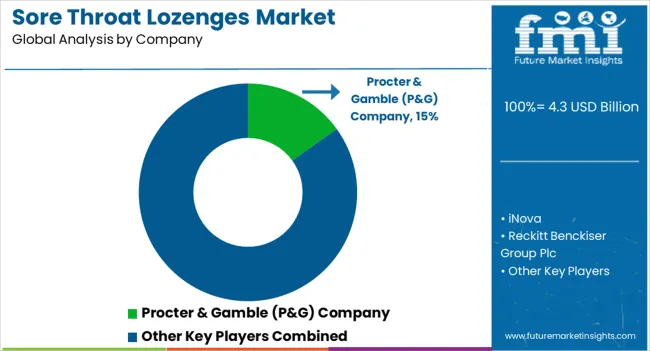
The market for sore throat lozenges is characterized by the presence of experienced competitors. These companies are focused on making decongestants easily accessible to the general public in large quantities. Key strategies employed by companies in the sore throat lozenges industry include new product innovation, launches, obtaining regulatory approvals, and expanding their operations. These strategies enable them to stay competitive and meet the evolving needs of consumers.
Recent Developments
| Attribute | Details |
|---|---|
| Forecast Period | 2025 to 2035 |
| Historical Data Available for | 2020 to 2025 |
| Market Analysis | USD billion for Value |
| Key Regions Covered | North America; Latin America; Europe; South Asia; East Asia; Oceania; and Middle East & Africa |
| Key Countries Covered | USA, Canada, Brazil, Mexico, Argentina, UK, Germany, Italy, Russia, Spain, France, Russia, BENELUX, India, Thailand, Indonesia, Malaysia, Japan, China, South Korea, Australia, New Zealand, Turkey, GCC, Israel, North Africa, and South Africa |
| Key Market Segments Covered | Product, Type, Distribution Channel, and Region |
| Key Companies Profiled | iNova Pharmaceuticals; Procter & Gamble (P&G) Company; Reckitt Benckiser Group Plc; Ricola AG; Mondelez International.; Thornton & Ross Ltd.; Traditional Medicinals, Inc.; Bliss GVS Pharma Ltd.; GlaxoSmithKline Plc; Honibe; SSL International; Cipla Ltd; Novartis; Johnson & Johnson |
| Pricing | Available upon Request |
The global sore throat lozenges market is estimated to be valued at USD 4.3 billion in 2025.
The market size for the sore throat lozenges market is projected to reach USD 7.5 billion by 2035.
The sore throat lozenges market is expected to grow at a 5.5% CAGR between 2025 and 2035.
The key product types in sore throat lozenges market are hard candy lozenges, soft lozenges and compressed lozenges.
In terms of type, otc segment to command 64.7% share in the sore throat lozenges market in 2025.






Full Research Suite comprises of:
Market outlook & trends analysis
Interviews & case studies
Strategic recommendations
Vendor profiles & capabilities analysis
5-year forecasts
8 regions and 60+ country-level data splits
Market segment data splits
12 months of continuous data updates
DELIVERED AS:
PDF EXCEL ONLINE
Cold, Cough, and Sore Throat Remedy Market Analysis – Size, Share & Forecast 2024-2034
Throat Sprays Market Analysis - Size, Share & Forecast 2025 to 2035
Strep Throat Treatment Market Analysis – Size, Share & Forecast 2025 to 2035
Ayurvedic Throat Care Market Size and Share Forecast Outlook 2025 to 2035

Thank you!
You will receive an email from our Business Development Manager. Please be sure to check your SPAM/JUNK folder too.
Chat With
MaRIA